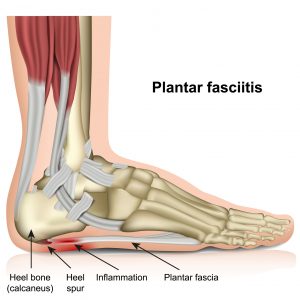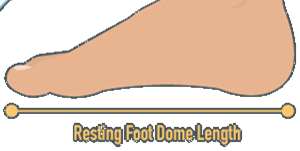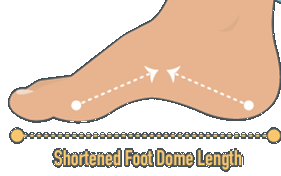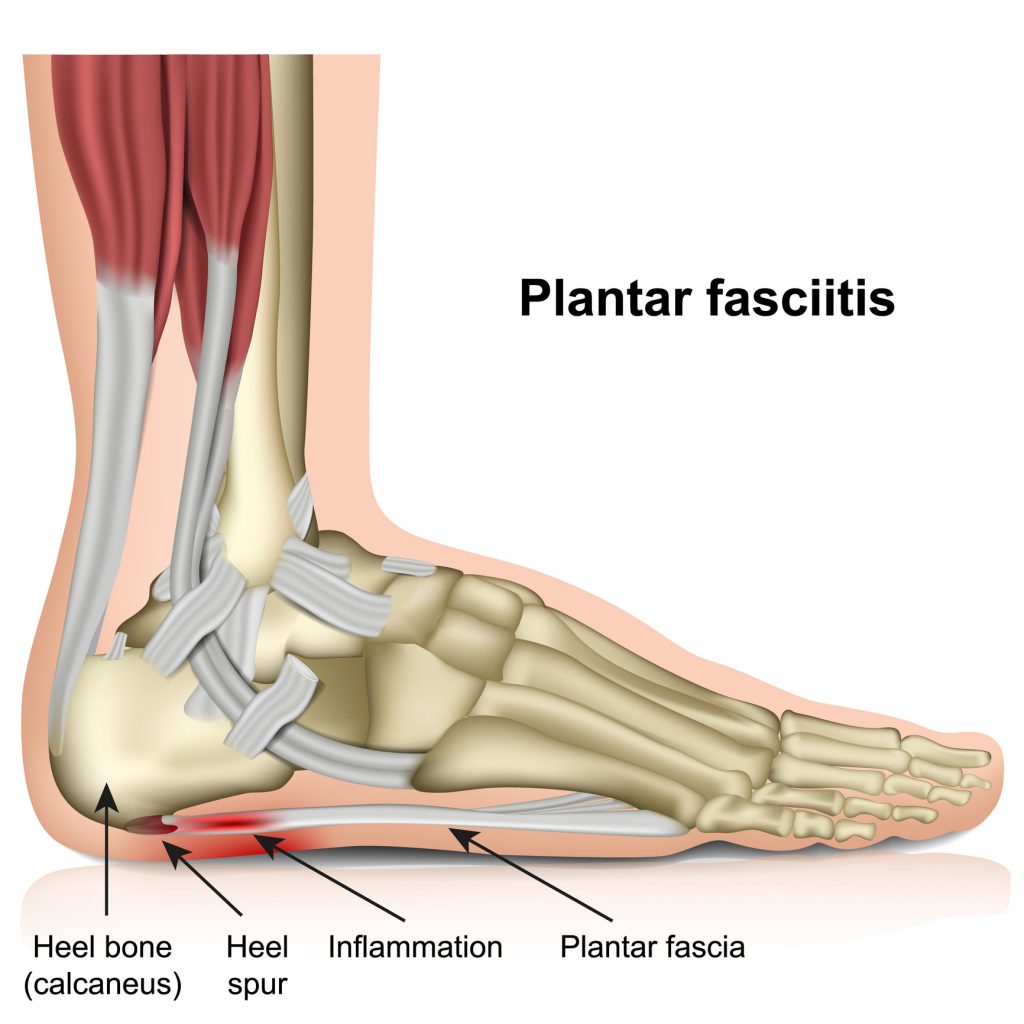
It’s not surprising that about 15% of all running injuries strike the foot. With each step your feet absorb a force several times your body weight.
While the foot is in motion during running, the plantar fascia, a thick elastic tissue that stretches from the heel to the base of the toes, works with the Achilles tendon to store and return energy
Because of this powerful attachment, the plantar fascia stabilises the inner forefoot as forces peak during push-off at the end of a stride.Unlike bone spurs & stress fractures of the heel, PF tends to produce pain during the push-off phase, and not during initial contact with the ground. Recent research has shown it to be similar to a tendinopathy.
Symptoms:
- A sharp stabbing pain or deep ache in the arch of your foot or in the middle of the heel.
- Stiffness or pain first thing in the morning (especially when you first get out of bed) that tends to lessen a bit with a few steps, but also tends to worsen as the day progresses
- Pain that worsens when climbing the stairs or standing on one’s toes.
- It is a notoriously nagging injury, and running through it, while possible, can delay healing.
- Often once you have warmed up and started running the pain eases only to return towards the end of a long run or later that day. Take care, this can become a vicious cycle.
The Cause:
Plantar fasciitis may result from a variety of factors
- Overtraining
- Vigorous repeated hill workouts or speed work
- Neglecting to stretch tight calf muscles
- Unsupportive shoes
- Starting a running programme too aggressively
- General lack of foot strength
- It can also be attributed to biomechanical factors such as fallen arches, pronation and tight Achilles tendons
The Fix:
- Lightly stretching and mobilising the fascia throughout the day by, rolling your foot over a golf ball or over a frozen water bottle.
- Wear supportive footwear with enough shock-absorbing cushioning through the day and avoid prolonged standing, especially on hard surfaces.
- Physical therapy to mobilise and release tightened fascia on the foot, as well as the ankle joint, calf and Achilles tendon.
- Massage therapy to release tight structures of the lower limb and foot.
- Night splints which holds the foot with the toes pointed up and the ankle at 90-degrees, can reduce morning symptoms
- Performing prescribed stretching and strengthening exercise for the foot and the hip/pelvis and your core.
THE PREVENTION:
- Run on a variety of surfaces, especially softer surfaces such as dirt paths, grass or trails, rather than concrete or asphalt.
- Make sure your running shoes are the right fit and support for your gait by going to a speciality running store and getting fitted.
- Ensure your training programme is right for your ability. Lastly, foot-strengthening exercises can go a long way to reducing future injuries.
- Tight hip flexors, a weak core and a history of low back pain can all contribute to injury – any of these issues can lead to subtle changes in your stride that you’ll feel in your feet.
- Have these issues addressed with physical therapy and a rehabilitation programme.
Feet Strengthening Exercises
Exercises that isolate and work the muscles in the toes might sound like a waste of time. After all, how strong do one’s toes really need to be?
But as the old saying goes, “the toe bone’s connected to the heel bone!” Each set of muscles and bones in your feet work together to distribute body weight, as well as the impact of running, walking, and jumping. By improving the strength and flexibility of one muscle group, you’re improving the stability of your arch and heel.
Foot-strengthening exercises promote long-term healing of plantar fasciitis by sharing the load of weight distribution and impact, as well as stabilizing gait problems and pronation — both of which commonly cause or worsen plantar fasciitis.


Object Pick Up
Sit in a chair with both feet planted on the floor in front of you. Scatter several small marbles, pebbles, or balls on the floor near your feet, so they can be picked up with your toes. Place a drinking cup or mug on the floor within easy reach of your foot. Try to pick up the marbles or pebbles using only your toes
Towel Squeeze
Sit in a straight-backed chair with your feet flat on the floor.
Lay a kitchen towel or hand towel on the floor in front of you so the short end is at your feet.
Put the toes of one foot on the end of the towel, and scrunch your toes so you pull the towel toward you.
Repeat five times with each foot.
You can increase the difficulty of this exercise by placing a small weight (like a can of soup) on the far end of the towel.



Arch Raise
Sit in a chair with the foot on the floor and the toes pointed forward.
Keeping the toes flat on the ground slide the front of the foot back along the floor toward the heel.
Hold the short foot position for 5-10 seconds.
Relax and repeat 10 times on each foot.
Contact Me
Let's chat!
Need more information? Send me an email or drop me a line. I don’t bite!
- Charlotte@rehabontheroad.co.uk
- 07971448719

